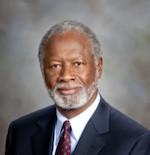Gov. DeWine has visited eight schools across the state so far that teach the science of reading — which is in his proposed budget

Second grade teacher Bernadette Monroe talks to her students during a visit by Ohio Governor Mike DeWine, Principal Miracle Reynolds (left), and Interim Superintendent/CEO of Columbus City Schools, Dr. Angela Chapman, to observe the implementation of the Science of Reading program, April 6, 2023, at Southwood Elementary School in Columbus, Ohio. (Photo by Graham Stokes for Ohio Capital Journal.)
Ohio Gov. Mike DeWine nodded along and smiled as the second grade students in Bernadette Monroe’s Southwood Elementary School classroom sounded out words like whistle, sketch and chuckle by emphasizing each letter Thursday morning.
Across the hall, in Robin Thalgott’s third grade classroom, students were practicing their syllables and studying words such as define, apron, and donate.
DeWine’s classroom visit to the state’s largest school district is part of his statewide tour of visiting schools that teach the science of reading. He has visited eight schools so far and plans to visit more classrooms around the state.
“I’ve been very impressed by what I’ve seen,” DeWine said.
DeWine’s proposed budget includes $64 million for science of reading curricula, $43 million each year for the next two years to offer science of reading instruction for educators, and $12 million to support 100 literacy coaches in schools and districts.
The science of reading is based on decades of research that shows how the human brain learns to read. Teaching using the science of reading incorporates phonemic awareness, phonics, fluency, vocabulary, and comprehension.
“It comes down to what goes on in that classroom,” DeWine said. “It’s all about the teacher, it’s all about the students. They have to get support. So as we try to implement this in every single classroom in the state we will make sure that schools get the support.”
DeWine said he has been talking to different legislators about the science of reading and encouraging them to visit a school district in their constituency that uses the science of reading to learn more about this approach to reading.
“Most teachers were not trained this way”

One of the challenges of incorporating the science of reading in every school district is many teachers have not been trained in this reading approach.
“We know that many teachers who are coming out of schools of education do not have this background,” DeWine said. “And it’s time to give them that background.”
DeWine’s proposed budget would include stipends for teachers to access professional development. There would be $1,200 stipends for teachers in grades K-5, English language teachers in grades 6-12, intervention specialists and instructional coaches. There would also be $400 stipends for middle and high schoolers teachers in other subject areas.
School districts like Columbus City Schools have used Language Essentials for Teachers of Reading and Spelling (LETRS) for their professional development.
DeWine said he has talked to many teachers who have embraced the science of reading, even though they might have been taught something different in college.
“Most teachers were not trained this way … I’ve had teachers tell me, I was reluctant about this, this was different, I didn’t really want to do it,” he said. “But once we started doing it, I could really see how it worked with the kids.”
Another challenge is some school districts have purchased a reading curriculum that is not backed by the science of reading.
The proposed budget would pay for school districts to get a new curriculum that aligns with the science of reading.
“We will pay 100% of that,” DeWine said.
The Ohio Department of Education doesn’t track which Ohio school districts are using which methods when it comes to the reading curriculum.
“We don’t really know what percentage (of the state’s school district aren’t using the science of reading),” DeWine said.
Columbus City Schools
Columbus City Schools started implementing the science of reading in 2021 and interim Superintendent Angela Chapman said the district realized they needed to change their curriculum four years ago.
“We were looking at our literacy data and recognizing that there were some gaps in some foundational skills — phonics, phonemic awareness,” she said. “It was then we decided that we wanted to have a systemic approach to address.”
The district has trained all of their elementary school teachers in LETRS during the past two years.
“This type of change does not happen overnight,” Chapman said. “It is systemic. It is a journey.”
Chapman shared a personal story about her first year teaching in Cleveland Heights-University Heights City Schools after graduating from the University of Akron with a degree in elementary education in 1997. Some students in her third grade class were at a first grade level and she remembers the textbook didn’t have the resources she needed to help those students.
“I found out very quickly as a first year teacher that I needed more tools in my toolbox,” she said.
• • •• • •
This story is provided by Ohio Capital Journal, a part of States Newsroom, a national 501 (c)(3) nonprofit. See the original story here.












